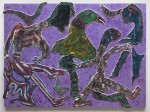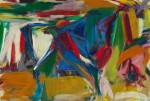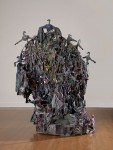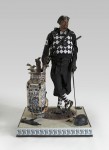Recent acquisitions place the Virginia Museum of Fine Arts at the forefront of museums and research institutions collecting African American art. These collecting areas are directly related to the museum’s strategic plan goal of significantly increasing VMFA’s holdings of African and African American art.
This strategic plan initiative also has inspired Pamela K. and William A. Royall, Jr., the president of VMFA’s Board of Trustees, to donate 18 works of art, half of which are by major contemporary African American artists.
VMFA now has its first two works by the late Alabama-based artist Thornton Dial: Old Uncle Buck (The Negro Got to Find Out What’s Going On in the United States), of 2002, and Freedom Cloth, of 2005. Dial, who passed away on January 25, 2016, was a self-taught artist whose paintings and assemblages of found objects were deeply rooted in the folk traditions, belief systems, and history of the South. Other gifts include Jack Whitten’s 2010 monumental painting Port au Prince: A Painting of Hope and Spirit for the Haitian People and recent works by emerging contemporary African American artists, such as Rashid Johnson, Titus Kaphar, and Charles McGill. Other significant artists whose work is included in this donation include Richard Artschwager, Shepard Fairey, Tristin Lowe, and Donald Sultan, along with a major 1958 painting entitled Bull by Elaine de Kooning.
“We are thrilled to increase our holdings of contemporary African American art through Bill and Pam’s extraordinary vision and generosity,” VMFA Director Alex Nyerges said. “The museum acquired its first work by an African American artist in 1944 when Leslie Garland Bolling’s 1935 sculpture Cousin-on Friday entered the collection. This commitment to living African American artists plays a vital role in VMFA’s strategic plan and we look forward to installing these works in our 21st-Century Gallery and sharing them with our visitors.”
Over the past several years, Pam and Bill Royall’s support has served as a catalyst in the growth of VMFA’s exceptionally strong collection of 21st century art. This year they have given 15 major works of contemporary art by 11 different artists, continuing their significant commitment to promoting the work of contemporary artists within the context of a global, encyclopedic museum. Many of these pieces have been borrowed by VMFA in the past for display in the 21st Century Gallery and three are currently on view. The familiarity of these works to regular visitors to the museum illustrates the central role they already play in VMFA’s narrative of contemporary art.
“It has been a tremendous privilege to work alongside the VMFA curators for the past several years and share their vision for building a dynamic, and provocative contemporary art collection that also resonates with the museum’s diverse audiences,” Bill Royall said. “Pam and I are also passionate supporters of the museum’s strategic focus on African and African American art and we are committed believers in the role that contemporary art can play in the community. We hope that the works we have donated will inspire and challenge VMFA’s visitors for many years to come. ”
Featured Artists:
Thorton Dial
Born in Alabama in 1928, Thorton Dial was a self-taught artist who began producing assemblage works during the second half of his life. Deeply private about his work, Dial did not gain wide recognition until the 1980s and 1990s when the art historian and dealer, William Arnett, brought his work to the attention of the larger art world. Considered an “outsider artist,” a problematic term due to the binary it suggests between trained and self-taught artists, Dial often blurred boundaries. Although deeply rooted in African-American folk traditions of the South, he also engaged with the history of canonical art. With his inventive use of found materials he addressed a complex mix of subject matter as he nimbly moved between current events, American history, African American experience, and spirituality. Freedom Cloth, adorned with eagle-like objects, provides a strong example of Dial’s exploration of the traditional symbols used to express American ideals. The bird figure and walking feet in the painting-collage, Uncle Buck (The Negro Got to Find Out What’s Going On in the United States), suggest one of Dial’s other longstanding interests, migration. Together these two iconic works offer a two-dimensional and a three-dimensional example of Dial’s now highly sought-after work. These are the first two works by Dial to enter VMFA’s collection.
Jack Whitten
Jack Whitten moved from Alabama to New York in 1959 to study art. Jazz and Abstract Expressionism were early inspirations as he began a painting career characterized for some 50 years by innovative materials and techniques. In February 2012, Art Forum featured a 1973 painting by Whitten on its cover, prompting art critics and curators to ask why Whitten’s work had not received more recognition earlier in his career, especially given that his scraped and squeegeed painterly abstractions of the 1970s predated by a decade similar works by the widely acclaimed German artist Gerhard Richter. Whitten’s work is now the subject of a major retrospective, Jack Whitten: Five Decades of Painting, which just closed at the Walker Art Museum. The artist made Port Au Prince: A Painting Of Hope And Spirit For The Haitian People shortly after the devastating earthquake in Haiti in 2010. A monumental piece formed by thousands of tiny tiles sliced from a thick skin of acrylic paint, the work’s surface involved more building than painting. Assembled like tesserae in a mosaic, the tiles surround brightly colored forms made by collaging and casting paint in the bottoms of plastic bottles. This recent work complements an earlier painting by the artist, Necklace for Mary, 1980, which enables the museum to represent the wide scope of his career.
Rashid Johnson
Born in Chicago in 1977, Rashid Johnson first established his reputation as a conceptual photographer. More recently he has also gained attention for assemblages and works like the The Sweet Science, which consists of symbols branded into red oak flooring. Johnson originally showed Sweet Science in an exhibition at Hauser & Wirth in 2011 titled “Rumble,” which referenced the gallery space’s previous life as a boxing arena, but also made reference to Muhammad Ali and George Foreman’s famous 1974 match in Zaire, popularly branded “The Rumble in the Jungle.” In his exhibition statement, Johnson explained his interest in the cultural tensions surrounding that historic fight, “In the 1970s, a lot of contradictory symbols and signifiers were occupying the same space in national consciousness.” The Sweet Science appears to literally place these signs and symbols on the same plane where they function like an undecipherable code: circles, diamonds, and palm trees share the composition with more suggestive patterns, such as a gun scope and the symbol for the elite African American fraternity Boulé. Johnson’s work can be found in many museum collections, including the Whitney Museum of American Art, the Art Institute of Chicago, and the Museum of Modern Art. This is the first work by the artist to enter VMFA’s collection.
Charles McGill
Inspired by his love of the sport, Charles McGill uses the metaphor of golf to explore issues of race and class, often transforming the “baggage” associated with the game into sharp critiques. His works include golf bags covered with racist imagery; photographs of himself teeing off in Harlem from a pile of watermelons; and the fictional avatar of Arthur Negro, sole founding member of the Former Militant Golf and Country Club. Four Men in Formal Attire (After Guston) is from McGill’s series Skins—which consists of collages of gutted and flayed golf bags. The use of found materials nods to John Chamberlain’s car-part sculptures and Claes Oldenburg’s soft vinyl works, while the rain hoods cap off an uncanny, even sinister, figurative presence, recalling Philip Guston’s Klansmen paintings from the 1970s. McGill’s lifelike sculpture Arthur Negro II adds to the museum’s extensive holdings of realism, particularly the sculptures of Duane Hanson. A manifestation of McGill’s fictionalized avatar, Arthur Negro II will be included as a key work in Charles McGill’s first major museum exhibition at the Boca Raton Museum of Art opening in April of 2016. These are the first works by McGill to enter the museum’s collection and offer a substantial representation of McGill’s oeuvre.
Titus Kaphar
Titus Kaphar’s work addresses history and representation as a mutable account subject to deconstruction and reconstruction in the present. The artist frequently paints his own versions of 18th- and 19th-century portraits, landscapes, and history paintings. He then defaces them by folding, cutting, and covering over—removing or obscuring figures to subvert expected narratives, allowing new meanings to arise. The new narratives often concern tensions between absence and presence, as in Voiceless, where a haze of paint obscures the man’s mouth. Kaphar’s deep concern with how history is written (and who writes it), informs his active engagement with current events and social justice. In 2014, Time commissioned Kaphar to produce a painting for the cover of its Fergusson issue that would speak to the experience of the protestors. In the resulting painting, Yet Another Fight for Remembrance, Kaphar repeats the central compositional element of Voiceless, painting over the mouths of three protestors who stand with their hands raised. Earlier this year Kaphar had a solo exhibition entitled The Jerome Project at the Studio Museum in Harlem and his work is in the collections of the Museum of Modern Art, the Studio Museum in Harlem, and the Seattle Art Museum. This is the first work by Titus Kaphar to enter VMFA’s collection.
Kristin Baker
Kristin Baker came to attention in 2003 for her explosive paintings inspired by Formula One car racing. From these she moved on to generalized catastrophic landscapes. Painting with trowels, palette knives, and squeegees on sheets of polyvinyl chloride (PVC), Baker builds her bright glossy surfaces by outlining each mark and shape with torn tape and filling in the interior. The forms are layered and sometimes scraped away to reveal the colors underneath. Her fractured images have a textural, handmade quality that emphasizes the materiality of paint and also a synthetic, virtual quality like 3-D digital imaging. Of Yore Posts marks a new series for Baker, who recently began making paintings that depict an open book marked by passages of abstract painting. Of Yore Posts joins another painting by Baker in VMFA’s collection, The Prig, deepening the museum’s holdings of this key 21st-century painter.
Shepard Fairey
Trained in illustration and graphic design, Shepard Fairey first gained notoriety in the 1990s as a street artist for his campaign of homemade stickers pasted around several New England cities. His work became more widely known during the 2008 U.S. presidential election, when he designed the celebrated Barack Obama “Hope” poster. Fairey uses the visual lexicons of advertising and propaganda to implore viewers to question their surrounding environment, rather than passively accept the messages broadcasted to them by corporate and government entities. In Risky Business, a faceless businessman holds an image of André the Giant, the former World Wrestling Federation champion and subject of Fairey’s viral “Obey Giant” street-art campaign of the 1990s. Made after the 2008 global economic crisis, the title—Risky Business—suggests the precariousness of the actions of the corporations that contributed to economic destabilization and turmoil. Although Fairey has gained notoriety for his projects in public spaces—many of which were illegal, Risky Business translates the scale, presence, and politics of his street art into a discrete painting and collage. Risky Business was featured in Los Angeles Museum of Contemporary Art’s 2011 exhibition Art in the Streets. It is the first work by Fairey to enter the collection.
Donald Sultan
After completing his MFA at the Art Institute of Chicago, Donald Sultan moved to New York in the mid 1970s and emerged as a key figure in the New Image movement of the late 1970s and early 1980s. Sultan’s paintings contrast simple, beautiful forms from nature—such as lemons and flowers—with an extremely physical process using industrial materials. Made with tar, enamel, tiling, and spackle, Twenty-Eight Colored Flowers has a palpable sense of texture that disrupts the uniformity of the painted image. Twenty-Eight Colored Flowers would join two other works by Sultan in the collection, Lemons, 1984, a gift from Sydney and Frances Lewis currently on view in the 1980s gallery, and a suite of drawings from the artist’s Trumpet series of 2007, a gift of the Royalls in 2011.
Tristin Lowe
Tristin Lowe often uses unexpected materials to explore the intersection between myth and science. Lowe’s neon sculpture of a comet takes its familiar shape from popular culture, while his title references one of the great scientific quests of the 20th and 21st centuries. Beginning in the 1960s, physicists sought to prove the existence of the Higgs boson, a subatomic particle popularly nicknamed “the God Particle” because of its association with theories of the origin of the universe. Made in 2011, the year before scientists finally confirmed the Higgs boson, Comet: God Particle gives form to the search for knowledge at the limits of human understanding. Turning on at regular intervals, its red glow appears suddenly, evoking questions about the cosmos and our place in it. Since being installed in time for 1708 Gallery’s InLight exhibition this past November, Comet has been enormously popular in its location on the Boulevard end of the Atrium where it lights up the museum campus both inside and out. This is the first work by Lowe to enter the museum’s collection.
Richard Artschwager
Over the past 40 years, Richard Artschwager’s work has confounded the distinction between painting, sculpture, and furniture. Using unconventional materials such as Formica and Celotex (a fibrous paper-composite often used for ceiling tiles), he has made paintings that incorporate three-dimensional space and sculptures that embrace pictorial illusion. Artschwager’s paintings usually represent generic images of architecture, interiors, or people. Williamsburg Pagoda , currently on view in the Sydney and Frances Lewis Galleries, is one of the artist’s few historical subjects. The building depicted is an arsenal in Colonial Williamsburg, an actual 1715 structure in an otherwise mostly reconstructed environment. Study for Williamsburg Pagoda is a sketch for the piece already in the museum’s collection, likely made in the same year.
Thomas Downing
Thomas Downing was born in Virginia in 1928, and studied at Randolph-Macon College. He received a Virginia Museum of Fine Arts Fellowship in 1950, which enabled him to travel to Europe. In the mid-1950s, he resettled in Washington, D.C. and began working with Kenneth Noland. Clement Greenberg included Downing in his important LACMA show, Post-Painterly Abstraction, which took place in 1964, the same year Downing made Untitled. One of his spot-paintings, for which he was best known, Untitled uses dots of varying sizes and shapes to create a visual tension that appears to move forward and backward in space. Untitled would join a later 1967 painting by Downing, deepening VMFA’s holdings of the artist’s work, while also strengthening the museum’s collection of Washington Color School artists, and artists with connections to Virginia.
Elaine de Kooning
While many Abstract Expressionists eschewed recognizable subject matter all-together, Elaine de Kooning, wife of the painter Willem de Kooning, frequently blurred the line between abstraction and figure painting. She used energetic, loose brushstrokes to paint dynamic portraits of figures as diverse as the dancer and choreographer Merce Cunningham and President John F. Kennedy. In 1957 she was a visiting professor at the University of New Mexico in Albuquerque and took the opportunity to travel throughout the West. After a visit to Juárez, Mexico, where she attended bullfights, the bull became a central motif in her painting for the next decade. Here, the bull, painted in a bright palette, offers an early, strong example from this key series. This is the first work by Elaine de Kooning to enter the collection and it substantially enriches the museum’s ability to tell a fuller and more diverse narrative of Abstract Expressionism.
About the Virginia Museum of Fine Arts
VMFA’s permanent collection encompasses more than 33,000 works of art spanning 5,000 years of world history. Its collections of African, Art Nouveau and Art Deco, English silver, Fabergé, and the art of South Asia are among the finest in the nation. With acclaimed holdings in American, British Sporting, Impressionist and Post-Impressionist, and Modern and Contemporary art – and additional strengths in Ancient, East Asian, and European – VMFA ranks as one of the top comprehensive art museums in the United States. Programs include educational activities and studio classes for all ages, plus lively after-hours events. VMFA’s Statewide Partnership program includes traveling exhibitions, artist and teacher workshops, and lectures across the Commonwealth. VMFA, a certified Virginia Green attraction, is open 365 days a year and general admission is always free. For additional information, telephone 804-340-1400 or visit www.vmfa.museum.
# # #





